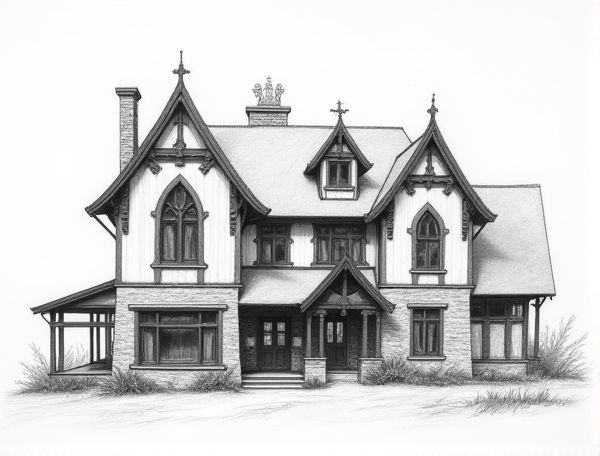
Photo illustration: Gothic revival home design with pointed arch windows
Showcase your unique style with Gothic Revival home design, characterized by striking pointed arch windows that create an elegant and timeless aesthetic. Discover more about how these architectural details can transform your living space by reading the full article.
Introduction to Gothic Revival Home Design
Gothic Revival home design features pointed arches, steep gables, and ornate woodwork that evoke medieval European architecture. Characterized by vertical lines and intricate details, this style creates dramatic, historic-inspired interiors and exteriors with elements like lancet windows and decorative tracery.
Key Characteristics of Gothic Revival Architecture
Gothic Revival architecture features pointed arches, ribbed vaults, and flying buttresses that emphasize verticality and light, creating an ethereal and dramatic interior space. Intricate ornamentation, including tracery windows, spires, and finials, showcases craftsmanship while steeply pitched roofs and lancet windows enhance the historic medieval aesthetic in residential design.
The Significance of Pointed Arch Windows
Pointed arch windows enhance your home design by blending Gothic architectural elegance with modern aesthetics, offering increased structural strength and visual height to interior spaces. Their distinctive shape allows more natural light to enter, creating an airy atmosphere that elevates ambiance and energy efficiency. Incorporating pointed arch windows can transform your home's facade with unique character while improving window durability and weather resistance.
Historical Background of Gothic Revival Style
Gothic Revival style emerged in the late 18th century, drawing inspiration from medieval Gothic architecture characterized by pointed arches, ribbed vaults, and flying buttresses. Prominent in 19th-century Europe and North America, this style symbolized romantic nationalism and was frequently used in churches, universities, and residential buildings.
Incorporating Pointed Arch Windows in Modern Interiors
Incorporating pointed arch windows in modern interiors enhances architectural character by blending Gothic elegance with contemporary minimalism, creating focal points that elevate natural light and spatial flow. These windows serve as functional art pieces, introducing vertical emphasis and historic charm while complementing sleek furniture and neutral color palettes. Strategic placement of pointed arch windows maximizes aesthetic impact and energy efficiency, making them ideal for living rooms, hallways, and staircases in modern home designs.
Materials and Color Palettes for Gothic Revival Homes
Gothic Revival homes commonly feature materials such as dark-stained wood, wrought iron, and stone with intricate carvings, emphasizing durability and ornate craftsmanship. Color palettes often include deep hues like burgundy, forest green, charcoal gray, and rich navy, complemented by creamy whites or muted gold accents to enhance the dramatic, historic ambiance.
Furniture and Decor to Complement Gothic Revival Design
In Gothic Revival design, furniture and decor should emphasize ornate woodwork, pointed arches, and rich, dark tones typical of the 19th-century medieval-inspired style. Choose carved oak pieces, velvet upholstery in deep reds or purples, and wrought iron accents to highlight the dramatic and romantic character of the space. Incorporate stained glass lamps, tapestry wall hangings, and intricate chandeliers to enhance the authentic Gothic atmosphere and create a cohesive, historically resonant interior.
Landscaping Ideas for a Gothic Revival Home Exterior
Enhance your Gothic Revival home's exterior with landscaping ideas that emphasize symmetrical patterns, dark-hued foliage, and wrought-iron garden fixtures to complement the architectural style's dramatic arches and intricate stonework. Incorporate elements like towering cypress trees, climbing ivy, and strategically placed lanterns to create an enchanting ambiance that highlights your home's historic charm.
Tips for Restoring or Renovating Gothic Revival Houses
Preserving original Gothic Revival features like pointed arches, ornate tracery, and steep gables enhances your home's historic charm while maintaining architectural integrity. Use period-appropriate materials such as wood, stone, and stained glass to restore windows, doors, and decorative elements authentically. Ensure modern upgrades, including insulation and electrical systems, are discreetly integrated to preserve the home's aesthetic without compromising comfort or safety.
Embracing Gothic Revival Style in Contemporary Living
Gothic Revival style in contemporary living features pointed arches, intricate tracery, and ornate woodwork that create a dramatic yet elegant atmosphere in modern homes. Integrating stained glass windows and vaulted ceilings enhances the historical essence while maintaining functional, open-concept layouts suited for today's lifestyle.
 homedesy.com
homedesy.com